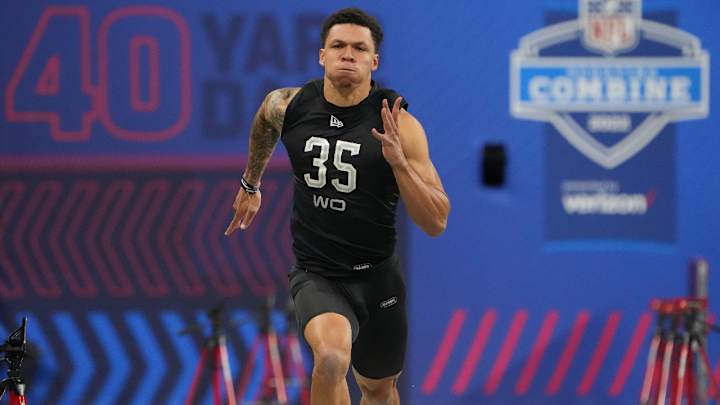Former NFL Scout Not Sold On Christian Watson

In this story:
Christian Watson was a decent college level receiver, but the narrative on Watson needs to be put back into proper perspective.
In four games in 2021, outside of two deep passes where Watson managed to get behind college subdivision secondaries, there was nothing special about him against Northern Iowa, South Dakota, Missouri State, Illinois State and Eastern Washington (Spring).
This was further confirmed by Watson’s overall college career. Watson finished last season as the No. 34 ranked FCS receiver.
2021: 43 receptions, 800 yards (18.6 avg.), 7 touchdowns
2020: 18 receptions, 437 yards (24.3 avg.), 1 touchdown
2019: 34 receptions, 732 yards (21.5 avg.), 6 touchdowns
2018: 9 receptions, 165 yards (18.3 avg.), 0 touchdowns
Does that look like a first-round resume?
My issue is not with Watson, his accomplishments, or North Dakota State.
My issue is with this narrative that has catapulted Watson into the first-round discussion.
As someone who was hired to work on staff with Hall-of-Fame coach Bill Parcells, it is absurd to think Watson belongs in the same sentence as game-breaking receivers such as Garrett Wilson, Treylon Burks or Jameson Williams.
Why?
This is the No. 1 rule with small school prospects in scouting: the prospect has to be dominant at that level to even have a chance.
Watson did not dominate.
His 4.36 40-yard dash at the Combine does not show up at all on game film in the short to intermediate parts of the field.
Watson barely was able to create enough separation against smaller school corners in man coverage at the intermediate route level. The throwing windows were tight.
#1 Christian Watson 2021 vs. Illinois State, Northern Iowa and Missouri State. pic.twitter.com/BmRVVTlk8W
— Whatever it Takes (@danielkellybook) April 13, 2022
He did not look crisp changing direction at the top of routes either. He labored some coming in and out of his breaks. In fact, his routes did not even look that polished - - or disciplined.
Watson was generally stopped right after receptions and unable to pick up YAC (yardage after the catch).
He was not elusive in the open field. When he did pick up yardage after the catch, it was in the soft spots of zone coverage and he was able to take what was there to take.
That Combine speed did not show up on the jet-sweeps or handoffs either when he was lined up in the backfield. Watson struggled consistently to hit the edge and turn the corner.
#1 Christian Watson 2021 vs. Missouri State, Northern Iowa and South Dakota. pic.twitter.com/fQKaQE8AIJ
— Whatever it Takes (@danielkellybook) April 13, 2022
Watson also looked as average as average can be on bubble screens.
Watson is more of a longer-distance runner who has building speed. It takes time (too much time) for him to reach full speed (which is where Watson’s deep straight-line speed shows up).
49ers’ fans can only hope general manager John Lynch and head coach Kyle Shanahan are not entertaining the thought of trading Deebo Samuel and selecting Watson to take his place.
Watson could not hold Samuel’s cup of Gatorade.
At best, Watson is a fourth-seventh round prospect (he is not on my big board), and even then teams have to know they are getting a receiver who is going to struggle to create separation in the NFL.
While Watson’s excellent concentration and long distance speed are his best attributes, his deep game leaves something to be desired. Watson was inconsistent high-pointing the deep ball, his vertical was mediocre as was his ability to adjust back to the ball.
There is no way an average athlete who does not have that coveted second gear or burst to the ball can be part of the first-round discussion.
There is no way a receiver with a limited catch radius (ability to catch passes thrown too high or too low) can be part of the first-round discussion.
Watson additionally lacks competitiveness. There were too many plays he took his foot off the gas and was seen not going full throttle.
The first-round Watson nonsense stops here.
He was the seventh best receiver in the Missouri Valley Conference last season for a reason.
Teams have to watch these four games before the draft, and slide Watson down their boards before it’s too late.
The film does not lie.

Daniel spent four years in pro scouting with the New York Jets and brings vast experience scouting pro and college talent. Daniel has appeared in many major publications, including the New York Times and USA Today. Author of Whatever it Takes, the true story of a fan making it into the NFL, which was published in 2013. He has appeared on podcasts around the world breaking down and analyzing the NFL. Currently writes for SI All Lions. You can contact Daniel at whateverittakesbook@gmail.com
Follow danielkellybook